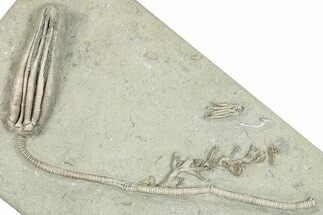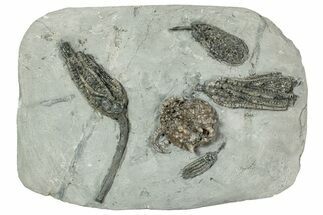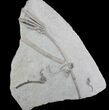This Specimen has been sold.
8.7" Hypselocrinus + 4 Other Species - Crawfordsville, Indiana
This is a nice plate from the Witherspoon Crinoid Quarry containing five different species of crinoids. The centerpiece on the plate is a 8.7" Hypselocrinus hoveyi including a very long section of stem. There is also a Scytalocrinus disparilis, Camptocrinus myelodactyins, Cyathocrinites multibrachiatus and an undescribed inadunate crinoid. They have been cleaned under microscope using air abrasives.
It is believed that crinoids from the Ramp Creek Limestone were buried in sediment from nearby deltas during storms. The resulting siltstone deposits are soft enough that fossils can be extracted in exquisite, three-dimensional relief.
It is believed that crinoids from the Ramp Creek Limestone were buried in sediment from nearby deltas during storms. The resulting siltstone deposits are soft enough that fossils can be extracted in exquisite, three-dimensional relief.
Crinoids, sometimes commonly referred to as sea lilies, are animals, not plants. They are echinoderms related to starfish, sea urchins, and brittle stars. Many crinoid traits are like other members of their phylum; such traits include tube feet, radial symmetry, a water vascular system, and appendages in multiples of five (pentameral). They first appeared in the Ordovician (488 million years ago) and some species are still alive today.
SPECIES
Hypselocrinus hoveyi, Scytalocrinus disparilis, Camptocrinus myelodactyins, Cyathocrinites multibrachiatus
LOCATION
Witherspoon Quarry, Crawfordsville, Indiana
FORMATION
Ramp Creek Limestone
SIZE
Largest crinoid 8.7"
CATEGORY
SUB CATEGORY
ITEM
#22779
We guarantee the authenticity of all of our specimens.
 Reviews
Reviews















